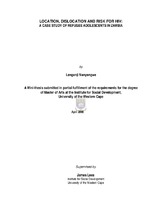Location, dislocation and risk for HIV: a case study of refugee adolescents in Zambia
Abstract
Refugees are not a new phenomenon and their plight has been felt the world over. Africa continues to see large numbers of people displaced through armed conflict, producing more refugees on the worlds’ most poverty stricken continent than any other. The implications of these displacements of people dislocated from their places of habitual residence create much concern, particularly in the wake of the HIV/AIDS pandemic. Such dislocations and displacements imply separation from family and communities, including socio-economic benefits that accrue to them. There is an apparent problem of accessing health services, educational services, sources of livelihood and protection from sexual and emotional abuse. Refugee children and women are said to be the most vulnerable, although until recently adolescents in armed conflict were not considered as a special group of children requiring special attention. The main objective of this research was to investigate levels of risk for HIV among refugee adolescents in Zambia and to determine how location relates to risk. Of particular interest was the difference in risk experienced in rural and urban areas. The researcher’s hypothesis was that refugee adolescents in rural camps of Zambia are at greater risk because they lack adequate sources of income, health, and education in comparison to urban areas. The research was located within two theoretical underpinnings namely the social cognitive theory and the AIDS Risk Reduction Model (ARRM). The theory posits that a reciprocal relationship exists between environmental contexts, personal factors and behavior. The model explains how people change behavior that reduces risk for HIV by changing perceptions on sexual activity and when they enact the knowledge obtained from HIV preventive programmes. The methodology was located within both the qualitative and quantitative research approaches. Qualitative because firstly, the research is a comparative case study and secondly, it is the first time such a study is being conducted. The researcher also made use of the quantitative through the survey and secondary HIV/AIDS statistical data.

